Your Strokes:
Andy Roddick's Backhand
Analyzed by John Yandell
Coaches and analysts have put forward many theories about the relative weakness of Andy Roddick's two-handed backhand and declarations about how he should improve it. "He needs to stand in and take it earlier." "He needs to choke up on his racket." "He needs to forget about it and just go for it." "He needs to hit more one-handed slice since his drive is such a liability."
But what is really happening technically in the shot? That is something I haven't heard anyone really explain, and the technical explanation tells the story. The real problem lies in the complex interplay between Andy's grips, his use of his hitting arms, and the path of his forward swing.
So let's use our video resources to delve into that, do a structural analysis and suggest a possible solution - even if it's highly unlikely that we'll ever see Andy adopt it. (More on that, and why, later.)
Let's start by saying that Andy could use his current backhand to blow 99.9% plus of all players on the planet off the court. But against the very best players in the world you can see that he lacks the equivalent pace, and he has an especially hard time going down the line on the run. It's not nearly as good as it really could be, given Andy's ability as a long time elite player.
How Many Two-Handers?
To understand why we have to understand the relationships between grips, hitting arm positions and how they affect the swing in the modern two-hander. It's commonly believed that the two-handed backhand is like a left-handed forehand with some additional strength and stability from the second hand. In some cases, that's true. But it's not that simple.
Our high speed video analysis shows that there are actually 3 major versions of the two-hander in the modern pro game, plus a fourth minor version. The fundamental difference between them is the shape of the hitting arms at the contact.
Players can hit with both arms straight at contact, like Rafael Nadal or Andre Agassi. They can hit with both arms bent like virtually all of the women and many of the top men. Or they can hit with the bottom or right arm bent and the left arm straight, like Andy Roddick. (Click Here to read a more detailed description of the hitting arm types.)
So is the problem with Andy that he uses this Bent/Straight hitting arm configuration? Is that somehow inferior to the other options? Not at all. Many of the top men, including Andy Murray and David Nalbandian - players with great backhands - are also Bent/Straight players.
Grips
So what then is the problem? It turns out that having the right grips are critical in the different hitting arm configurations. A grip structure that works perfectly well with one hitting arm combination is a liability with another.
With the top or left hand, most players use either an eastern forehand or a 3 / 3 in our grip terminology. (Click Here). Or they rotate the left hand somewhat toward the top of the hand, taking the heel pad up to the second bevel, more like a 2 / 3. Either one works fine with any of the major hitting arm structures. The problem is with the bottom or right hand.
And that is Andy's fundamental technical problem. He has the wrong grip with his bottom or right hand for the Bent/Straight hitting arm structure
If you look at Andy's bottom or right hand, he definitely shifts the grip somewhat from his forehand grip when he moves to the backhand side. But this shift is far less than most of the two-handed players in the game, and especially less than the other top players with Bent/Straight configurations. You couldn't call it a backhand or even a mild continental.
This problem with this weak grip is that creates a fatal flaw in the shape of the stroke, and limits his ability to generate power and to hit certain placements. Why? Because it leads to a much weaker positioning of the racket at the start of the forward swing.
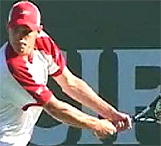 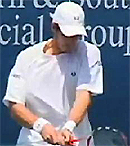 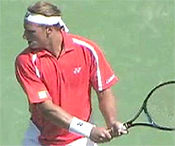 |
The Bent/Straight variation requires a significant grip shift with the bottom hand. |
This weaker grip wouldn't matter, or matter as much, if Andy was using the Bent/Bent hitting arm structure. The amount of the shift is less critical in that variation. Although many Bent/Bent players - think of Lindsay Davenport, or Mario Ancic, or Novak Djokovic--have a significant grip shift, players like Venus Williams and Serena Williams hit the shot beautifully with a bottom hand grip similar to Andy's.
Why is the grip less important in the Bent/Bent variation? Because with the Bent/Bent structure, the top or left hand plays much more of a role in initiating the forward swing, similar to the forehand side. So the contribution is less.
But with the top arm straight, the bottom arm is critical initiating the swing. When the top arm is straight, it's adding to the swing with a push around, or starting just before the contact. So the initial swing is coming from the bottom arm. Let's see how that works.
All groundstroke swings in tennis are from the inside out. This means that the hands start close to the body and travels on an arc outward and forward to the contact. To initiate this motion from the inside out with the Bent/Straight configuration, you need a strong pull forward with the bottom hand. The top or left arm comes in later. So to do that you need at least some version of a backhand grip.
This means a grip that you could use to at least hit a one-handed backhand flat or with a small amount of topspin. So you see players like Murray or Nalbandian shift the grip with the bottom hand to something like a 2 / 1, or a 2 / 1 1/2. This means the index knuckle is on the second bevel and the heel pad is at least partially on the top bevel of the racket grip. (To understand this grip terminology with the bottom hand, Click Here.) If you want to use verbal terminology you can call it a Continental or a mild verision of the Continental.
Some of the Bent/Straight players actually go even further and use stronger backhand grips with the bottom hand, for example Carlos Moya or Lleyton Hewitt. They shift the index knuckle much closer to bevel 1 on the top of the frame, or at least to the edge between 2 and 1. This is a relatively mild version of an Eastern Backhand grip.
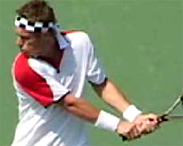 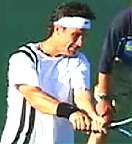
|
|
Some Bent/Straight two-handers use a stronger
grip with the bottom hand. |
But Andy doesn't get anywhere near where the other Bent/Straight players do. You can see that he shifts his bottom hand in the direction of a backhand grip, but his index knuckle is positioned on the edge between bevel 2 and bevel 3. His heel pad appears to be partially on bevel 2. To me that doesn't even qualify as some version of a continental.
Try it yourself. You might be able to hit a one-handed slice with this grip, but it's awkward or impossible if you actually try to drive the ball or hit with even a little topspin.
So the problem Andy faces is that, with the Bent/Straight configuration, he has to initiate the forward swing with the bottom hand like a one-handed backhand. But he doesn't have a one-handed backhand grip that allows him to do this in the right way.
And now we are in position to understand the other major difference in Andy's swing, compared with virtually ever other top two-hander in the game. As we said above, the forward swing on the two-hander, like all good groundstrokes, begins inside, close to the body and travels on an inside out arc or curve to the contact.
Andy's backhand has far less of this inside out component in the forward swing than any two-hander in the pro game. He starts the forward swing much further away from this body. Although it usually has a mild inside out component, sometimes it appears that he is swinging directly forward, or even from the outside in.
Why does Andy start from this outside position? Try it yourself. Establish the same weak bottom hand grip he uses and try a one-handed swing. The inside position is hopeless. There is simply no way to get the racket head squared up to the ball. (After all this is why we change grips to hit a one-hander in the first place!)
The only chance you have to get any leverage on the ball with that grip is to move it much further to the outside, at a distance from your body of say, one and a half feet. Now you can get some pull forward with the bottom hand, but it is still relatively much weaker than an inside out swing with a true backhand grip.
So this is the only way Andy can use his right hand, by starting the forward swing from a much more outside position. This also explains why Andy's right elbow tends to lead the stroke much more than the other Bent/Straight players. Again, it's the only way he has to use the bottom arm. Starting outside, and pulling forward from the elbow.
You can compare this starting position in the high speed footage with Carlos Moya, both hitting Bent/Straright backhands shot on the same court filmed from the same camera angle.
So with Andy his two-handed backhand is more like a one and a half handed backhand. It robs him of just enough power to make a liability in exchanges with other top players.
This weak outside position is also what makes is so much more difficult for him to hit with power down the line. Watch again what happens when he is on the run and how swings forward virtually on a straight line, as if he were trying to shovel the ball down the line. Not a pretty sight.
So what's the solution? Well there is a technical answer, and then there is a practical answer.
First, from the technical point of view, he would need to shift the grip further, and this in turn would allow him to shift to an inside starting position for the forward swing. To get the feel of how the bottom arm works he could start by hitting a few hundred one-handed drives with the new grip. Another strategy would be to just ask Andy to shift to a more extreme inside position and see if he didn't naturally adjust the grip himself. If he did then you could have him experiment with the one-hander, and then put it back together.
Another theoretical solution would be to change his hitting arm structure to the Bent/Bent. And then establish the same inside position, reduce the role of the top hand, and hit a far more left handed version. But that would truly be a radical change, a change that would be very unlikely for any top player make, and especially for Andy at this point in his career.
So much for the technical, and on to the practical. Bu you know what? Even that small grip shift is a titanic change at the highest levels of pro tennis. Maybe you hit a few good ones - maybe way better ones--in practice, but very likely the first few matches things are going to get worse. And everyone is already saying your backhand is terrible. How do you deal with that? It's one thing to take the right attitude and commit to becoming better technically as a junior or a club player. It's another on the world stage in the last few years of your career with so much riding on every match, not to mention his Davis Cup career.
I have a lot of stories about players and coaches and technical changes. I worked with John McEnroe to re-engineer his serve in the last years of his career - but he used himself in the glory days as a model. (Click Here to read about that.)
Carlos Rodriquez used high speed video we provided to revamp Justine Henin's forehand and serve, arguably critical in her rise to the very top. And I hope someday he'll write about that experience for us. It's probably the only example of a top player continuing to evolve technically once having reached such a high level.
But I've seen other players (and coaches) who have been less receptive, and it's perfectly understandable. When I showed Paul Annacone how Pete Sampras had developed an elbow lead on his one-handed backhand, and we analyzed the motion together frame by frame, he totally bought it, but then said he would never show it to Pete. I asked why and his answer was "Pete thinks his backhand is fine - this would blow his mind."
Last year I filmed Jelena Jankovic's serve at the request of her then physical trainer Pat Etcheberry. She could make a big jump in my view if she moved her motion more toward the male serving model, like Henin did. (Click Here.) But this year when I asked her tour coach Ricardo Sanchez if he wanted to take a look he said he was going to be very busy.
I had a similar experience with Larry Stefanki, someone I'd worked with before, when I approached him about Andy. I knew him from the time when our work with Johnny Mac overlapped and I shared the video of the serve work with him. This time he told me he had plenty of his own video and had been a coach on the tour for 30 years, blah, blah, blah.
To be honest, it fascinating to see how the wealth of knowledge from the video revolution is or isn't utilized at the highest levels of the game. It must be tough to be a 50 year old coach and at the mercy of a player 30 years younger who can change his or her mind in the blink of an eye.
But regardless of any benefit, or non-benefit to Andy, there is a lesson here is for all you two-handers who may be struggling or want to improve. You need to video yourself and check out your own hitting arm positions, and then compare that with your grip structures. If they need adjusting it can result in a big jump in the stroke.
And back to Andy. Andy's backhand may always be Andy's backhand, but when you watch him play in the future, at least you'll understand why he struggles with it compared to the rest of his game.




